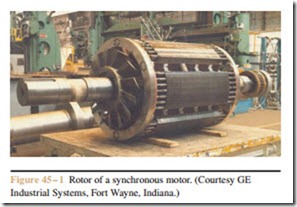Synchronous motors are so named because of their ability to operate at synchronous speed. They are able to operate at the speed of the rotating magnetic field be- cause they are not induction motors. They exhibit other characteristics that make them different than squirrel cage or wound rotor induction motors. Some of these characteristics are:
• They can operate at synchronous speed.
• They operate at a constant speed from no load to full load. Synchronous motors will either operate at synchronous speed or they will stall and stop running.
• They can produce a leading power factor.
• They are sometimes operated without load to help correct plant power factor. In this mode of operation, they are called synchronous condensers.
• The rotor must be excited with an external source of direct current.
• They contain a special squirrel cage winding called the amortisseur winding that is used to start the motor.
Starting a Synchronous Motor
A special squirrel cage winding, called the amortisseur winding, is used to start a synchronous motor. The rotor of a synchronous motor is shown in Figure 45 – 1. The amortisseur winding is very similar to a type A squirrel cage winding. It provides good starting torque
and a relatively low starting current. Once the synchronous motor has accelerated to a speed close to that of the rotating magnetic field, the rotor is excited by connecting it to a source of direct current. Exciting the rotor causes pole pieces wound in the rotor to become electromagnets. These electromagnets lock with the rotating magnetic field of the stator and the motor runs at synchronous speed. A synchronous motor should never be started with excitation applied to the rotor. The magnetic field of the pole pieces will be alternately attracted and repelled by the rotating magnetic field, resulting in no torque being produced in either direction. High induced voltage, however, may damage the rotor windings and other components connected in the rotor circuit. The excitation current should be connected to the rotor only after it has accelerated to a speed that is close to synchronous speed.
